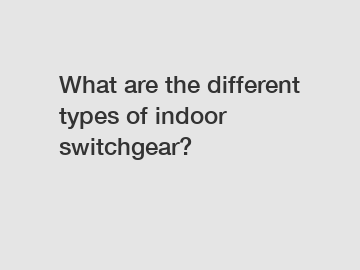What are the different types of indoor switchgear?
Different Types of Indoor Switchgear.
Switchgear plays a crucial role in the electrical power system by controlling, protecting, and isolating electrical equipment. It acts as a mediator between the power source and the electrical equipment, ensuring the safe and efficient distribution of electricity. There are various types of switchgear available for indoor use, each designed to cater to specific requirements. In this article, we will explore different types of indoor switchgear and their applications.
Air-Insulated Switchgear (AIS).

A commonly used type of switchgear is the air-insulated switchgear (AIS). As the name suggests, this type of switchgear uses air as the insulation medium between various phases. AIS is typically used in low voltage electrical systems due to its simplicity, low cost, and ease of maintenance. It is commonly found in residential buildings, small commercial establishments, and industrial facilities where the power demands are relatively low.
Gas-Insulated Switchgear (GIS).
In high voltage applications, such as power plants and substations, gas-insulated switchgear (GIS) is preferred. Unlike AIS, GIS uses sulfur hexafluoride (SF6) gas as the insulating medium. SF6 gas has excellent electrical insulation properties, high dielectric strength, and is non-flammable and non-toxic. GIS offers compactness, high reliability, and enhanced safety features, making it suitable for densely populated areas or locations with limited space for switchgear installations.
Metal-Enclosed Switchgear.
Metal-enclosed switchgear is a type of switchgear that provides a high level of protection to the electrical equipment and personnel. It consists of metal enclosures that house the various components of the switchgear, including circuit breakers, busbars, and control mechanisms. Metal-enclosed switchgear is widely used in industrial facilities, power generation plants, and large commercial buildings where safety is of utmost importance.
Ring Main Units (RMU).
For distribution networks, especially in urban areas, ring main units (RMU) are commonly used. RMUs are compact switchgear units that are installed on distribution feeders to supply power to various loads. They are designed to provide reliable and efficient operation, with the ability to quickly restore power in case of a fault. RMUs are suitable for indoor installation, making them ideal for urban areas with limited space.
Withdrawable Switchgear.
Withdrawable switchgear, as the name suggests, allows the circuit breaker module to be completely withdrawn from the switchgear for maintenance or replacement purposes. This type of switchgear offers a high degree of flexibility and convenience in terms of maintenance, as the faulty components can be replaced without interrupting the power supply. Withdrawable switchgear is commonly used in critical installations where downtime is not an option.
Conclusion.
In conclusion, the different types of indoor switchgear cater to various electrical power system requirements, ensuring the safe and efficient distribution of electricity. Air-insulated switchgear (AIS) is suitable for low voltage applications, while gas-insulated switchgear (GIS) is preferred for high voltage applications. Metal-enclosed switchgear offers a high level of protection, while ring main units (RMU) are used in distribution networks. Withdrawable switchgear provides flexibility and convenience during maintenance activities.
If you have any further questions or need assistance with choosing the right type of switchgear for your needs, please do not hesitate to contact us.
For more information, please visit vacuum circuit breakers, power transformer supplier, vacuum circuit breaker working principle.

Comments
0